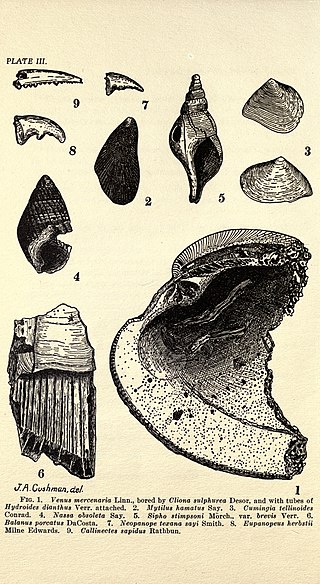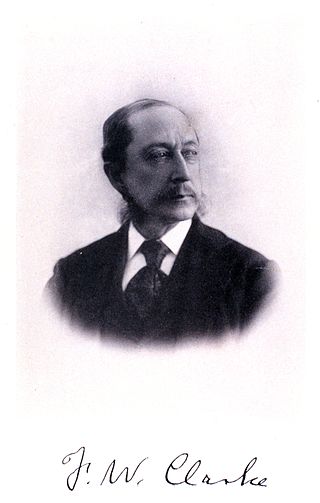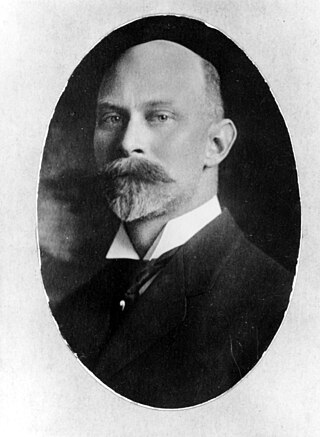
Charles Doolittle Walcott was an American paleontologist, administrator of the Smithsonian Institution from 1907 to 1927, and director of the United States Geological Survey. He is famous for his discovery in 1909 of well-preserved fossils, including some of the oldest soft-part imprints, in the Burgess Shale of British Columbia, Canada.

Spencer Fullerton Baird was an American naturalist, ornithologist, ichthyologist, herpetologist, and museum curator. Baird was the first curator to be named at the Smithsonian Institution. He eventually served as assistant Secretary of the Smithsonian from 1850 to 1878, and as Secretary from 1878 until 1887. He was dedicated to expanding the natural history collections of the Smithsonian which he increased from 6,000 specimens in 1850 to over 2 million by the time of his death. He also served as the U.S. Commissioner of Fish and Fisheries from 1871 to 1887 and published over 1,000 works during his lifetime.

Robert Ridgway was an American ornithologist specializing in systematics. He was appointed in 1880 by Spencer Fullerton Baird, secretary of the Smithsonian Institution, to be the first full-time curator of birds at the United States National Museum, a title he held until his death. In 1883, he helped found the American Ornithologists' Union, where he served as officer and journal editor. Ridgway was an outstanding descriptive taxonomist, capping his life work with The Birds of North and Middle America. In his lifetime, he was unmatched in the number of North American bird species that he described for science. As technical illustrator, Ridgway used his own paintings and outline drawings to complement his writing. He also published two books that systematized color names for describing birds, A Nomenclature of Colors for Naturalists (1886) and Color Standards and Color Nomenclature (1912). Ornithologists all over the world continue to cite Ridgway's color studies and books.

Joseph Augustine Cushman was an American micropaleontologist and academic. He specialized in the study of marine protozoans (foraminifera) and became the foremost foraminiferologist of the first half of the twentieth century, developing to a "world-famous system of discovering petroleum deposits". He also was a founding father of Kappa Delta Phi fraternity.
The Sternberg peer review controversy concerns the conflict arising from the publication of an article supporting pseudoscientific intelligent design creationism in a scientific journal, and the subsequent questions of whether proper editorial procedures had been followed and whether it was properly peer reviewed.

Frank Wigglesworth Clarke of Boston, Massachusetts, and Washington, D.C. was an American scientist and chemist. Sometimes known as the "Father of Geochemistry," Clarke is credited with determining the composition of the Earth's crust. He was a founder of The American Chemical Society and served as its President, 1901.

Stephen Alfred Forbes was the first chief of the Illinois Natural History Survey, a founder of aquatic ecosystem science and a dominant figure in the rise of American ecology. His publications are striking for their merger of extensive field observations with conceptual insights. Forbes believed that ecological knowledge was fundamental for human well being. Forbes was important to the development of ecological theory. He was acknowledged by the National Academy of Sciences as "the founder of the science of ecology in the United States".
The American Journal of Biological Anthropology is a peer-reviewed scientific journal and the official journal of the American Association of Biological Anthropologists. It was established in 1918 by Aleš Hrdlička.
Frederick Knab was an artist and entomologist active from the 1880s through the 1918, most noted for his oil paintings and illustrations and his work with coleopterous and dipterous insects.

Richard Charles Banks was an American author, ornithologist and Emeritus Research Zoologist on staff with the Patuxent Wildlife Research Center run by the U.S. Geological Survey and stationed at the Smithsonian Institution in Washington, D.C. He is the founder of the Ornithological Council and known for his study of the migratory systems, patterns, and geographic variations of North American birds, primarily focusing on the research and analysis of Greater White-fronted Geese.

Thomas Wayland Vaughan was an American geologist and oceanographer. He worked with the United States Geological Survey and United States National Museum, investigating the geology of the West Indies, Panama Canal Zone, and the eastern coast of North America. In 1924 Vaughan became director of the Scripps Institution of Oceanography and held the post until his retirement in 1936. His research work concentrated on the study of corals and coral reefs, the investigation of larger foraminifera, and oceanography.

Marcus Ward Lyon Jr. was an American mammalogist, bacteriologist, and pathologist. He was born into a military family, and demonstrated an early interest in zoology by collecting local wildlife around his father's army posts. He graduated from Brown University in 1897, and continued his studies at George Washington University while working part-time at the United States National Museum (USNM). At the same time, he taught at Howard University Medical School and later George Washington University Medical School. He received his Ph.D. from George Washington University in 1913. In 1919, he and his wife, Martha, moved to South Bend, Indiana to join a newly opened clinic. Prior to moving, Lyon had published many papers on mammalogy, both during and after his tenure at the USNM. In these papers, he had formally described six species, three genera, and one family. Once in South Bend, he began to publish medical studies, too, but continued his work in mammalogy, with a particular focus on the local fauna of Indiana. He published more than 160 papers during his career.

Thomas Robert Soderstrom was an American agrostologist His special field of study was the grass family Gramineae or Poaceae. He was Curator of Grasses at the National Museum of Natural History in Washington, DC for some twenty years.
Joan Murrell Owens was an American educator and marine biologist specializing in corals. She received degrees in geology, fine art, and guidance counseling. She described a new genus, Rhombopsammia, and three new species of button corals, R. niphada, R. squiresi, and Letepsammia franki.

Vicki Ann Funk was an American botanist and curator at the Smithsonian's National Museum of Natural History, known for her work on members of the composite family (Asteraceae) including collecting plants in many parts of the world, as well as her synthetic work on phylogenetics and biogeography.
Lynne R. Parenti is an American ichthyologist. She serves as a Research Scientist and Curator of Fishes at the National Museum of Natural History of the Smithsonian Institution. Her specialty is the systematics and historical biogeography of freshwater and coastal fishes, and she has conducted research in this area for about thirty years.
Frederick Baker was an American physician and civic activist in San Diego, California. He was the prime mover in founding the Marine Biological Institution, which became the Scripps Institution of Oceanography. He was also a co-founder of the Zoological Society of San Diego and thus of the San Diego Zoo. He was a naturalist and an amateur malacologist.
Mildred Stratton Wilson was an American zoologist, whose work on copepods was awarded a Guggenheim Fellowship in 1955.
Beryl B. Simpson is a professor emerita in the Department of Integrative Biology at the University of Texas at Austin. Previously she was an associate curator at the Smithsonian National Museum of Natural History in the Department of Botany. She studies plant systematics and tropical botany, focusing on angiosperms found in the American Southwest, Mexico, and Central and South America. She was awarded the José Cuatrecasas Medal for Excellence in Tropical Botany for her decades of work on the subject.

Mary Foley Benson was an American scientific illustrator and fine artist. She specialized in detailed, realistic watercolor paintings of plants and insects.












